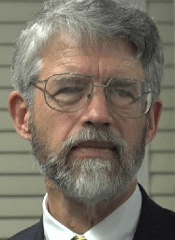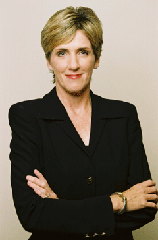Prioritizing Climate Solutions
Air Date: Week of April 17, 2009

John Holdren is Science Advisor to the President.
The nation's most influential energy and climate change policy makers gathered at MIT to set goals for the future. The challenges are daunting and the dangers are real. President Obama's climate czar, Carol Browner, and chief science advisor, John Holdren, attended the MIT summit.
Transcript
YOUNG: Here in Washington the Obama administration has just made a major decision on global warming. The Environmental Protection Agency will use the Clean Air Act to regulate greenhouse gases. It’s the first time the federal government has set limits on carbon dioxide emissions.
The decision means EPA will begin a rule-making process that could lead to curbs on the CO2 coming from some sources like vehicles and power plants. EPA’s decision satisfies the requirements of a major Supreme Court ruling on greenhouse gases. And it will put pressure on Congress to enact a broader system to address climate change.
CURWOOD: And here in Massachusetts, Obama’s top energy and science advisers came to visit to one of the country’s leading science institutions: MIT in Cambridge. It’s part of a bid to get America rolling on developing innovative technologies as well policies to combat climate disruption.
With $150 billion to spend on scientific discovery and technological innovation over the next decade, the race is already on to turn this federal funding into employment and equipment. Carol Browner, assistant to the President for Energy and Climate Change, gave the keynote address in an auditorium overflowing with engineers, researchers and business developers.

Carol Browner.
CURWOOD: But if America wants to lead this century, Carol Browner says, we’re first going to have pull ourselves out of the last one.
BROWNER: In the late nineteenth when Thomas Edison opened the Pearl St. power plant in Manhattan he pioneered an electricity delivery system that gave American industry what they needed to lead the world. Sadly if Edison were alive today he’d be all too familiar with the current system we rely on. Not that much has changed. I think we can all agree that we can do better than we did in 1882.
CURWOOD: In fact, many other nations are already doing better.
BROWNER: Europe and Asia have taken the lead in solar energy. In Germany wind power now supplies three percent of its total electricity production; Spain wind accounts for eleven percent; and in Denmark, nineteen percent - here, less than one percent, placing us just ahead of China and behind India.
CURWOOD: For John Holdren, Assistant to the President for Science and Technology, the event was something of a homecoming. The presidential science advisor began his training at MIT as a rocket scientist back in the early sixties after he was inspired by President Kennedy’s call to go to the Moon.
John Holdren compared that effort to the present task of changing our energy systems sufficiently and quickly enough to avert looming climate disaster.
HOLDREN: The energy challenge we face is actually a more difficult challenge than putting a man on the moon was and its more difficult in a variety of respects - we have to do things that pervade our whole economy, not just this country but around the world in order to get it done to the degree that is required. So it will take more than an Apollo program, more than a Manhattan project that produced the first nuclear weapons to get this done but we certainly have in this institution, in this country, and around the world, the talent that we need.
CURWOOD: To get emissions down to a level where he says there would be at least a 50-50 chance of avoiding climate catastrophe, John Holdren said the worldwide goal is to stop emitting the equivalent of nine billion tons of CO2 a year.
How to get there? He cited several options, each good for about one gigaton—that is a billion tons.
HOLDREN: We would have to cut energy use in all the world's buildings 20- 25% below business as usual.
Two billion cars would need to get 60 mpg rather than 30 to get one gigaton of carbon per year. 700 nuclear power plants would need to replace coal burning power plants to get one gigaton. A million two-megawatt wind turbines would need to replace coal burning power plants to get one gigaton of carbon per year. The 2005 rate of tropical deforestation would have to be cut in half approximately to get a gigaton.

John Holdren.
HOLDREN: Mitigation, meaning the things we can do to reduce the pace and magnitude of the changes in global climate that we are causing. Adaptation, meaning measures that we take to reduce the adverse impacts on human well being that result from the changes in climate that do occur. And the third option - we have to be frank about it - is suffering the adverse impacts that we fail to avoid by either mitigation or adaptation.
CURWOOD: Presidential science advisor John Holdren, speaking at MIT in Cambridge, Massachusetts.
[MUSIC: Horacio “El Negro” Hernandez/Robbie Ameen “Hit This, Split This (Producer Mix)” from El Negro And Robbie At The Third World War (American Clave 2004)]
[SOUND OF CROWS]
YOUNG: Just ahead – three years ago, the town of Auburn, New York was inundated with 30,000 crows. But with perseverance, the town sent the birds on the wing.
DELFAVERO: I mean we were getting calls all the time. “What are we going to do about this?” “I can’t get down my sidewalk.” “My car’s covered with it. You gonna pay for washing it.” It was like a constant barrage of calls. Now it’s a handful of year. And that’s because you might have a 100 crows in one tree near a residential area or whatever.
YOUNG: Find out how they did it. Keep listening to Living on Earth!
Links
To learn more about John Holdren, click here
Listen to a 2006 Living on Earth interview with Carol Browner
Living on Earth wants to hear from you!
Living on Earth
62 Calef Highway, Suite 212
Lee, NH 03861
Telephone: 617-287-4121
E-mail: comments@loe.org
Newsletter [Click here]
Donate to Living on Earth!
Living on Earth is an independent media program and relies entirely on contributions from listeners and institutions supporting public service. Please donate now to preserve an independent environmental voice.
NewsletterLiving on Earth offers a weekly delivery of the show's rundown to your mailbox. Sign up for our newsletter today!
 Sailors For The Sea: Be the change you want to sea.
Sailors For The Sea: Be the change you want to sea.
 The Grantham Foundation for the Protection of the Environment: Committed to protecting and improving the health of the global environment.
The Grantham Foundation for the Protection of the Environment: Committed to protecting and improving the health of the global environment.
 Contribute to Living on Earth and receive, as our gift to you, an archival print of one of Mark Seth Lender's extraordinary wildlife photographs. Follow the link to see Mark's current collection of photographs.
Contribute to Living on Earth and receive, as our gift to you, an archival print of one of Mark Seth Lender's extraordinary wildlife photographs. Follow the link to see Mark's current collection of photographs.
 Buy a signed copy of Mark Seth Lender's book Smeagull the Seagull & support Living on Earth
Buy a signed copy of Mark Seth Lender's book Smeagull the Seagull & support Living on Earth

